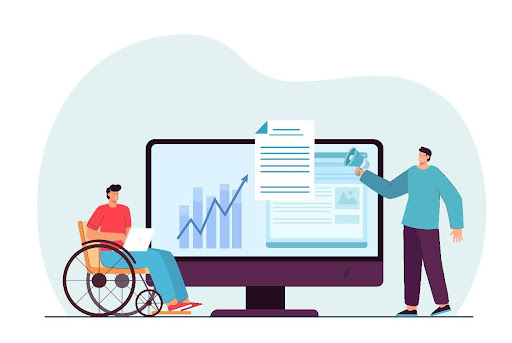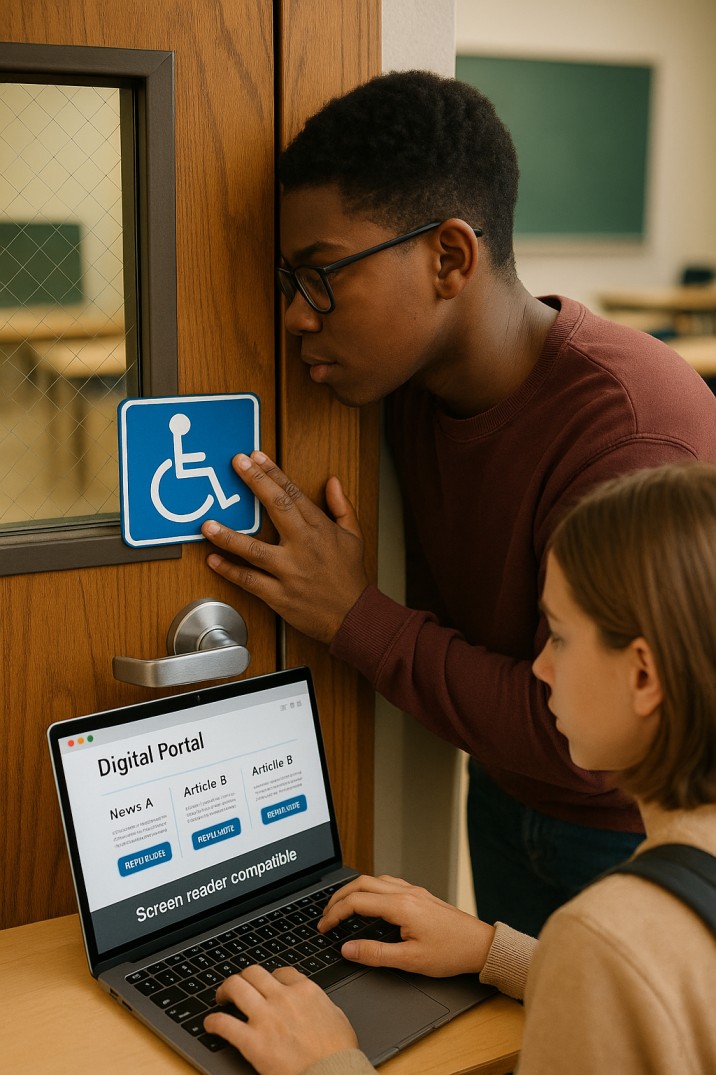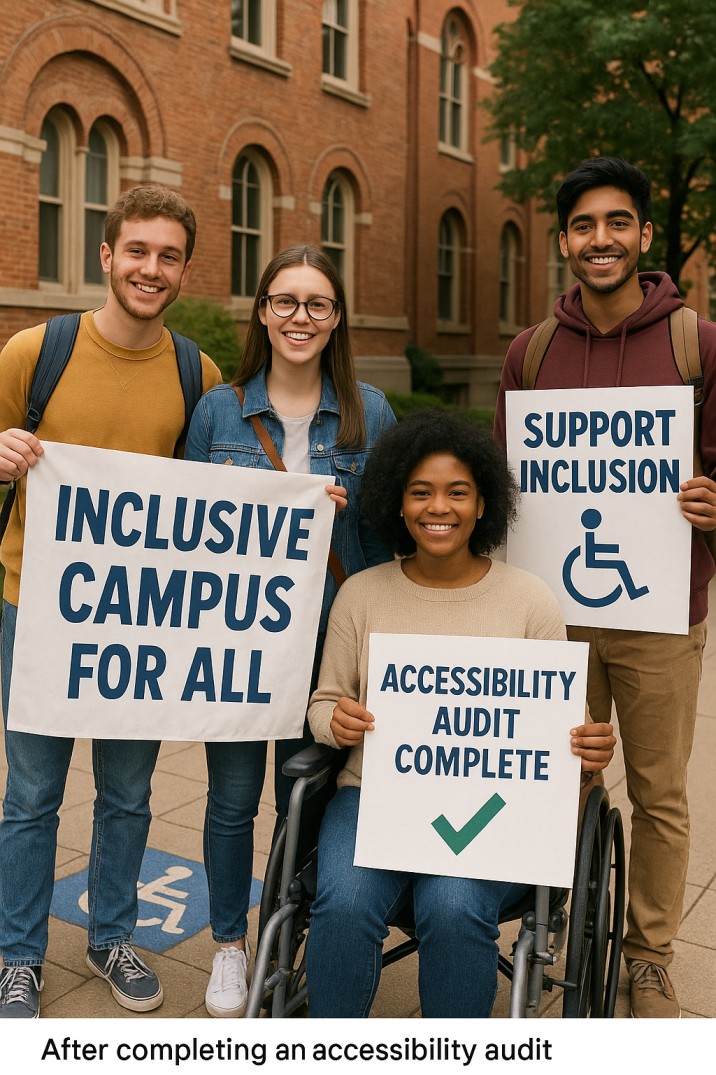
One needs to understand that establishing areas where everyone, regardless of any ability, can fully engage. By carrying out accessibility audits on their campuses and in their communities, student organizations from all around the world are taking the initiative to make sure this vision is accomplished. These accessibility audits by student groups are essential for a proper analysis of digital, social, and infrastructural facilities to make sure they go hand in hand to meet the needs of the specially-abled. Such programs help in establishing the groundwork for an inclusive campus where equal opportunity is the norm.
An essential first step in locating obstacles and putting solutions in place is an accessibility audit by student groups. Let’s examine some effective ways for carrying out accessibility audits and promoting diversity in higher education.
- Promoting awareness
Many students don’t realize how difficult it is for their peers with disabilities to perform day-to-day tasks. Student groups witness these obstacles directly when they participate in these audits. This approach helps the students develop a sense of empathy and consciousness by transforming abstract concepts into lived experiences.
- Identifying Gaps in Infrastructure and Digital Access
Accessibility audits by students see whether labs, libraries, classrooms, and residence halls are accessible to all. They make sure digital platforms such as online learning portals, university websites, and event registration systems are increasingly being audited as well. Students look for assistive technology compatibility, color contrast, font legibility, and captioning. They assist institutions in moving toward full accessibility by drawing attention to both digital and physical deficiencies.

- Stakeholder collaboration
To learn about living experiences, student organizations frequently speak with individuals with disabilities directly. This partnership guarantees that various pressing issues, which can hinder the routine of any disabled person, are given top priority. Additionally, collaborations with NGOs and disability activists contribute technical know-how, which enhances the legitimacy and usefulness of student audits.
- Constructing reports
The presentation of findings is where an accessibility audit’s strength rests. Typically, student groups create thorough reports that contain images, grades, and useful suggestions. Rather than just highlighting shortcomings, they offer practical and reasonably priced fixes, such as adding handrails, upgrading digital platforms, making sure auditoriums have accessible seating, or upgrading signs. These helpful reports assist administrators in viewing accessibility as attainable rather than daunting.
- Promoting Sustainable Change
Advocacy is arguably the most effective function of accessibility audits by student groups. Students frequently use audit results to advocate for financial distribution, improvement schedules, or policy changes. Some even assist their organizations in submitting funding applications for improvements in accessibility. Student groups make sure that the improvements go beyond paper promises and result in actual transformation by following up after the audit. Their work frequently serves as inspiration for larger community projects such as inspecting parks, cultural venues, and transportation hubs.

Challenges faced by the student groups
Student-led audits are promising, but they also present difficulties. Inadequate technical knowledge may result in assessments that are not complete. Students may be discouraged from seeking audits because administrators may view them as disrespectful. The ability to suggest or carry out significant improvements is also restricted by financial limitations. Partnerships with local governments, non-governmental organizations, or corporate social responsibility initiatives, however, can help in reducing these difficulties.
Conclusion
Accessibility audits by student groups demonstrate that significant change can begin inside student communities. These organizations make sure that accessibility becomes a part of campus life by identifying obstacles, making useful suggestions, and advocating for changes. Colleges that accommodate such programs are considered to enjoy superior and inclusive facilities and student participation and leadership.
The ultimate goal must be to create an inclusive campus in which every student has an equal opportunity to participate in academics, social life, and community life. Every inclusive campus constructed today represents a step toward a time when accessibility will be a necessary component of education rather than an elective.
References
[1] | https://www.cipcourses.com/blog/how-to-ace-your-campus-accessibility-audit/. |
[2] |
FAQs
1. What are accessibility audits?
Accessibility audits are structured assessments that evaluate whether physical spaces, digital platforms, or social systems are inclusive and accessible to all individuals, especially people with disabilities. These audits look at features like ramps, signage, elevators, screen-reader compatibility, and website usability. Accessibility audits ensure that institutions are not just legally compliant but also ethically committed to inclusivity.
2. Why are they important in educational institutions?
Accessibility audits are essential in schools, colleges, and universities because they directly impact the learning experience of students with disabilities. Without audits, many barriers go unnoticed, such as inaccessible classrooms, online learning portals that lack captions, or libraries without assistive technologies. Conducting accessibility audits helps institutions identify these challenges and implement meaningful solutions that foster equal participation.
3. Who conducts these audits?
Accessibility audits can be performed by trained professionals, third-party organizations, or student groups passionate about inclusion. In many cases, student-led accessibility audits are highly effective because students directly witness challenges faced by their peers. Collaboration with NGOs, disability advocates, or accessibility consultants can further enhance the credibility and thoroughness of these audits.
4. What areas are usually examined during accessibility audits?
Audits cover both physical and digital spaces. Physically, they assess ramps, elevators, signage, restrooms, classrooms, and residential halls. Digitally, audits examine learning portals, university websites, mobile apps, and online registration platforms. They check for color contrast, font readability, captioning on videos, and compatibility with assistive tools like screen readers.
5. How do accessibility audits promote awareness among students?
When student groups conduct accessibility audits, they witness firsthand the barriers faced by people with disabilities. For example, struggling to access a lecture hall without a ramp helps students realize challenges that often go ignored. These experiences transform abstract concepts into lived realities, encouraging empathy, awareness, and long-term advocacy for inclusion.
6. Can digital accessibility audits make a difference?
Yes, digital audits are crucial. In today’s era of online learning, students rely heavily on websites, portals, and e-learning platforms. If these digital resources are inaccessible, it directly excludes students with visual, auditory, or cognitive disabilities. Accessibility audits of digital systems ensure proper font legibility, high contrast, closed captions, and compatibility with assistive technologies, making online education more inclusive.
7. What role do student groups play in accessibility audits?
Student groups act as change agents in accessibility audits. They conduct inspections, document gaps, and prepare reports for administrators. Unlike external auditors, students have an insider’s perspective of campus life and can highlight issues that outsiders might miss. Their involvement also builds leadership, advocacy skills, and a deeper sense of responsibility toward inclusivity.
8. How do accessibility audits encourage stakeholder collaboration?
Accessibility audits often involve collaboration between student groups, faculty, disability rights activists, and NGOs. Students may interview peers with disabilities to understand real-life experiences, while NGOs contribute technical expertise. This collaboration ensures that audit results are both practical and empathetic, leading to actionable solutions that are rooted in lived experiences.
9. What is included in an accessibility audit report?
A well-prepared accessibility audit report typically includes:
Photographs of problem areas.
Grading systems for accessibility levels.
Lists of barriers identified (e.g., no elevator access).
Practical recommendations (e.g., adding tactile paving, updating websites for screen readers).
Such reports not only point out shortcomings but also provide cost-effective solutions, making accessibility improvements more achievable for institutions.
10. How can accessibility audits promote sustainable change?
Accessibility audits are not just one-time assessments—they initiate long-term change. Student groups use audit findings to advocate for policy updates, budget allocations, and infrastructural improvements. By following up with administrators, they ensure that accessibility is integrated into institutional planning rather than treated as an afterthought.
11. What challenges do student groups face in conducting accessibility audits?
Student-led audits face obstacles such as limited technical knowledge, lack of funding, and resistance from administrators who may view audits as criticism. Some students also struggle to gain institutional support for implementing suggested changes. However, partnerships with NGOs, government agencies, or corporate social responsibility programs can help overcome these barriers.
12. How can institutions benefit from accessibility audits?
Colleges and universities benefit greatly from accessibility audits because they:
Improve inclusivity and campus reputation.
Attract a diverse student population.
Reduce the risk of legal challenges related to disability rights.
Enhance student satisfaction and retention.
Ultimately, accessibility audits help institutions align with global standards of education and equity.
13. Are accessibility audits legally required?
In many countries, yes. Legal frameworks such as the Americans with Disabilities Act (ADA) in the United States or the Rights of Persons with Disabilities Act (RPWD) in India require educational and public institutions to ensure accessibility. Accessibility audits help organizations comply with these laws and avoid penalties while promoting fairness.
14. How can accessibility audits extend beyond campuses?
Student groups often expand their accessibility audits beyond universities, evaluating public spaces like libraries, cultural centers, transportation systems, and parks. This community involvement ensures that inclusivity is not limited to academic settings but becomes a broader social movement that benefits everyone.
15. What is the ultimate goal of accessibility audits?
The ultimate goal of accessibility audits is to create environments—both physical and digital—where every individual, regardless of ability, can fully participate in academic, social, and community life. By identifying barriers, proposing solutions, and advocating for policy change, accessibility audits pave the way toward an inclusive future in education and beyond
Penned by Samidha Taneja
Edited by Ragi Gilani, Research Analyst
For any feedback mail us at [email protected]
Transform Your Brand's Engagement with India's Youth
Drive massive brand engagement with 10 million+ college students across 3,000+ premier institutions, both online and offline. EvePaper is India’s leading youth marketing consultancy, connecting brands with the next generation of consumers through innovative, engagement-driven campaigns. Know More.
Mail us at [email protected]